-
 Effects of Different Ranges of Loads on Physical Performance Using Velocity-Based Resistance Training
Effects of Different Ranges of Loads on Physical Performance Using Velocity-Based Resistance Training -
 Acute Effects of Short Static, Dynamic, and Contract–Relax with Antagonist Contraction Stretch Modalities on Vertical Jump Height and Flexibility
Acute Effects of Short Static, Dynamic, and Contract–Relax with Antagonist Contraction Stretch Modalities on Vertical Jump Height and Flexibility -
 Comparison of Hormonal, Inflammatory, Muscle Damage and Oxidative Stress Biomarkers Changes in Response to High-Intensity Interval, Circuit and Concurrent Exercise Bouts
Comparison of Hormonal, Inflammatory, Muscle Damage and Oxidative Stress Biomarkers Changes in Response to High-Intensity Interval, Circuit and Concurrent Exercise Bouts -
 Impact of Re-Warm-Up During Resistance Training: Analysis of Mechanical and Physiological Variables
Impact of Re-Warm-Up During Resistance Training: Analysis of Mechanical and Physiological Variables
Journal Description
Sports
Sports
is an international, peer-reviewed, open access journal published monthly online by MDPI. The Strength and Conditioning Society (SCS), The European Sport Nutrition Society (ESNS) and The European Network of Sport Education (ENSE) are affiliated with Sports and their members receive discounts on the article processing charges.
- Open Access— free for readers, with article processing charges (APC) paid by authors or their institutions.
- High Visibility: indexed within Scopus, ESCI (Web of Science), PubMed, PMC, and other databases.
- Journal Rank: JCR - Q1 (Sport Sciences) / CiteScore - Q2 (Physical Therapy, Sports Therapy and Rehabilitation)
- Rapid Publication: manuscripts are peer-reviewed and a first decision is provided to authors approximately 18.7 days after submission; acceptance to publication is undertaken in 3.7 days (median values for papers published in this journal in the first half of 2025).
- Recognition of Reviewers: reviewers who provide timely, thorough peer-review reports receive vouchers entitling them to a discount on the APC of their next publication in any MDPI journal, in appreciation of the work done.
Impact Factor:
2.9 (2024);
5-Year Impact Factor:
3.3 (2024)
Latest Articles
From Amateur to Professional Cycling: A Case Study on the Training Characteristics of a Zwift Academy Winner
Sports 2025, 13(7), 234; https://doi.org/10.3390/sports13070234 (registering DOI) - 16 Jul 2025
Abstract
This study aimed to describe the training leading to the Zwift Academy (ZA) Finals of a world-class road cyclist who earned a professional contract after winning the contest. Four years of daily power meter data were analyzed (male, 25 years old, 68 kg,
[...] Read more.
This study aimed to describe the training leading to the Zwift Academy (ZA) Finals of a world-class road cyclist who earned a professional contract after winning the contest. Four years of daily power meter data were analyzed (male, 25 years old, 68 kg, VO2max: 85 mL·min−1·kg−1, and 20-minute power: 6.37 W·kg−1), focusing on load, volume, intensity, and strategies. Early training alternated between long, moderate-intensity sessions and shorter high-intensity sessions, with easy days in between. Gradually, the structure was progressively modified by increasing the duration of moderate-intensity (MIT) and high-intensity (HIT) and, subsequently, moving them to “high-volume days”, creating a sort of “all-in days” with low-intensity (LIT), MIT, and HIT. Moderate use of indoor training and a few double low-volume, low-intensity sessions were noted. These data provide a deep view of a 4-year preparation period of ZA, providing suggestions for talent identification and training, thereby highlighting the importance of gradual progression in MIT and HIT.
Full article
Open AccessArticle
Trends in Antidepressant, Anxiolytic, and Cannabinoid Use Among Italian Elite Athletes (2011–2023): A Longitudinal Anti-Doping Analysis
by
Mario Ruggiero, Leopoldo Ferrante, Domenico Tafuri, Rosaria Meccariello and Filomena Mazzeo
Sports 2025, 13(7), 233; https://doi.org/10.3390/sports13070233 - 16 Jul 2025
Abstract
Mental health disorders, particularly depression and anxiety, have become increasingly prevalent among elite athletes, exacerbated by factors such as competitive pressure and the Coronavirus Disease 19 (COVID-19) pandemic. This study analyzes trends in the use of antidepressants, anxiolytics, and cannabinoids (delta-9-tetrahydrocannabinol (THC)/cannabidiol (CBD))
[...] Read more.
Mental health disorders, particularly depression and anxiety, have become increasingly prevalent among elite athletes, exacerbated by factors such as competitive pressure and the Coronavirus Disease 19 (COVID-19) pandemic. This study analyzes trends in the use of antidepressants, anxiolytics, and cannabinoids (delta-9-tetrahydrocannabinol (THC)/cannabidiol (CBD)) among Italian athletes from 2011 to the first half of 2023 (FH2023), referring to anti-doping reports published by the Italian Ministry of Health. Data from 13,079 athletes were examined, with a focus on non-prohibited medications, banned substances, and regulatory impacts, including threshold adjustments for THC since 2013 and the legalization of CBD. The results show fluctuating use of antidepressants/anxiolytics, with peaks in 2021 and the FH2023, coinciding with post-pandemic awareness. Positive THC cases rose following regulatory changes, reflecting socio-cultural trends. Gender disparities emerged, with THC use predominantly among males (e.g., nine males vs. one female in 2013), though female athletes were underrepresented in testing. This study highlights the need for personalized, evidence-based strategies that balance therapeutic efficacy and anti-doping compliance. Clinicians should carefully consider prescribing selective serotonin reuptake inhibitors (SSRIs) and benzodiazepines to address depression and anxiety and should monitor the risks of CBD contamination. Future research should adopt longitudinal, gender-sensitive approaches to refining guidelines and combating stigma in professional sports.
Full article
(This article belongs to the Topic Recent Advances in Physical Education and Sports)
►▼
Show Figures
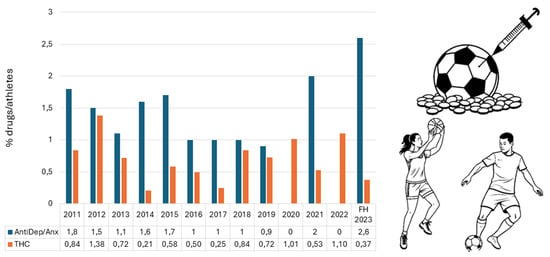
Graphical abstract
Open AccessArticle
The Role of Perfectionism and Sport Commitment on Exercise Addiction Among Hungarian Athletes
by
Tamás Berki, Zsófia Daka and Andor H. Molnár
Sports 2025, 13(7), 232; https://doi.org/10.3390/sports13070232 - 14 Jul 2025
Abstract
►▼
Show Figures
Exercise addiction (EA) is a maladaptive behavior characterized by excessive physical activity, often linked to negative psychological outcomes. This study investigated the relationships between perfectionism, sport commitment, and EA in a sample of 219 Hungarian athletes (M = 22.19 years). Using path analysis,
[...] Read more.
Exercise addiction (EA) is a maladaptive behavior characterized by excessive physical activity, often linked to negative psychological outcomes. This study investigated the relationships between perfectionism, sport commitment, and EA in a sample of 219 Hungarian athletes (M = 22.19 years). Using path analysis, we tested a model hypothesizing that adaptive and maladaptive perfectionism differentially predict enthusiastic and constrained commitment, which in turn influences EA. Our results showed that maladaptive perfectionism positively predicted constrained commitment (β = 0.70) and EA (β = 0.63), while negatively relating to enthusiastic commitment (β = −0.17). Conversely, adaptive perfectionism was positively associated with enthusiastic commitment (β = 0.24) and negatively with constrained commitment (β = −0.12). Moreover, enthusiastic commitment positively predicted EA (β = 0.24). We found a significant indirect effect between adaptive and maladaptive perfectionism when controlling for enthusiastic commitment, suggesting its dual role in this context. Our study suggests that enthusiastic commitment serves as a source of exercise addiction (EA) and has a dual role, acting as both a protective factor and a risk factor for it. Additionally, we found that maladaptive perfectionism is associated with higher levels of constrained commitment and EA, while correlating with lower levels of enthusiastic commitment. Conversely, adaptive perfectionism increases enthusiastic commitment and decreases constrained commitment. These findings highlight the associations between motivational and personality factors in EA, indicating that even adaptive traits can contribute to unhealthy exercise patterns in athletic environments.
Full article

Figure 1
Open AccessArticle
Breathing Reserve and Lung Function in Female Elite Runners
by
Ferdinand Grov Kyte, Karoline Holsen Kyte, Linn Skinstad, Jonny Hisdal and Trine Stensrud
Sports 2025, 13(7), 231; https://doi.org/10.3390/sports13070231 - 14 Jul 2025
Abstract
►▼
Show Figures
Breathing reserve (BR) is the remaining proportion of achievable minute ventilation that remains unutilized at total exhaustion during exercise. Previous studies have found a smaller BR in endurance-trained athletes compared to untrained controls. However, most of these studies have examined men. Given that
[...] Read more.
Breathing reserve (BR) is the remaining proportion of achievable minute ventilation that remains unutilized at total exhaustion during exercise. Previous studies have found a smaller BR in endurance-trained athletes compared to untrained controls. However, most of these studies have examined men. Given that women have a greater ventilatory limitation than stature-matched men, the present cross-sectional study aimed to investigate how this sex difference influences BR and lung function tests in endurance-trained females compared to matched, untrained females. To obtain further insight, we also aimed to investigate whether VO2max serves as a predictor of BR. We examined 15 female elite runners and 15 healthy, matched female controls aged 24–33 years with regard to pulmonary function, MVV, VEmax, BR, and VO2max. The elite runner group had a median BR of 5%, while that of the controls was 21%, representing a significant difference. Lung function tests showed no differences between the two groups. A moderate association was found between VO2max and BR. The female elite runners demonstrated a lower BR than the group of matched, untrained controls, which was lower than that found for male elite athletes in previous studies. This may indicate a greater ventilatory demand in female relative to male endurance athletes.
Full article
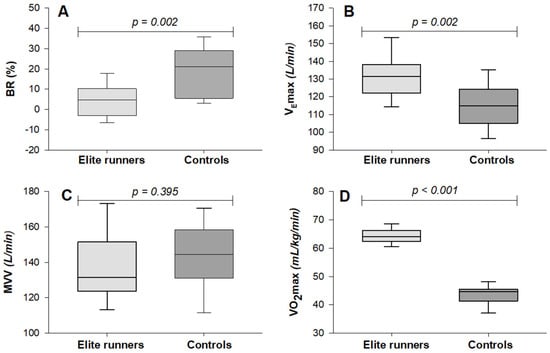
Figure 1
Open AccessArticle
Neuromuscular Fatigue Profile of Prepubertal and Adult Female Handball Players
by
Anastasia Papavasileiou, Eleni Bassa, Anthi Xenofondos, Panagiotis Meletakos, Konstantinos Noutsos and Dimitrios A. Patikas
Sports 2025, 13(7), 230; https://doi.org/10.3390/sports13070230 - 11 Jul 2025
Abstract
The investigation of the neuromuscular components of fatigue in team sports, especially in developmental ages, is limited. This study aimed to examine the neuromuscular fatigue and recovery patterns in prepubertal and adult female handball players, focusing on the soleus (SOL) and tibialis anterior
[...] Read more.
The investigation of the neuromuscular components of fatigue in team sports, especially in developmental ages, is limited. This study aimed to examine the neuromuscular fatigue and recovery patterns in prepubertal and adult female handball players, focusing on the soleus (SOL) and tibialis anterior (TA) muscles. Fifteen prepubertal (11.1 ± 0.9 years) and fourteen adult (22.0 ± 3.4 years) females performed a sustained isometric plantar flexion at 25% of maximal voluntary contraction (MVC) until exhaustion. The electromyographic (EMG) activity of the SOL and TA, torque, and central activation ratio (CAR) were recorded throughout the experiment. Endurance time was similar between groups (girls: 104 ± 93.5 s; women: 94.4 ± 30.2 s, p > 0.05), and both demonstrated progressive increases in muscle activation, without significant group differences for SOL and TA EMG (p > 0.05). Following fatigue, the torque and soleus (SOL) EMG activity decreased significantly compared to the pre-fatigue values in both groups (p < 0.001) and recovered (p > 0.05) in prepubertal and adult females within the first 3 and 6 min, respectively. The CAR remained unchanged over time, without significant differences observed between age groups (p > 0.05). These findings suggest that neuromuscular responses to fatigue are comparable between prepubertal and adult females, but recovery is significantly faster in prepubertal girls. Consequently, these findings underscore the need for age-specific recovery strategies in training programs, with tailored exercise-to-rest ratios to enhance performance and reduce fatigue during handball-specific activities.
Full article
(This article belongs to the Special Issue Factors and Biological Mechanisms Underlying Exercise Performance in Children)
►▼
Show Figures

Figure 1
Open AccessArticle
The Role of School Environment on the Sustainable Development of Pre-Schoolers’ Motor Creativity
by
Despoina Ourda, Anna Kavoukoglou, Athanasios Gregoriadis and Vassilis Barkoukis
Sports 2025, 13(7), 229; https://doi.org/10.3390/sports13070229 - 11 Jul 2025
Abstract
This study examined the influence of student–teacher relationships and school infrastructure on preschool children’s motor creativity, encompassing fluency, originality, and imagination. Twenty teachers completed the Student–Teacher Relationship Scale for 200 children (10 children per teacher). The research team recorded aspects of the school’s
[...] Read more.
This study examined the influence of student–teacher relationships and school infrastructure on preschool children’s motor creativity, encompassing fluency, originality, and imagination. Twenty teachers completed the Student–Teacher Relationship Scale for 200 children (10 children per teacher). The research team recorded aspects of the school’s physical environment through Movement Play Scale and assessed children’s motor creativity via the Thinking Creatively in Action and Movement test. The results revealed that dimensions of the student–teacher relationship, such as conflict and dependency, negatively impacted fluency, and originality components of motor creativity. Contrary to expectations, teacher participation in movement activities did not significantly contribute to motor creativity, potentially due to over-direction limiting children’s autonomy. Similarly, the school’s infrastructures were negatively linked to fluency and originality. The findings underscore the importance of nurturing autonomy-supportive environments and balancing guidance with opportunities for independent exploration. Teachers should also invest in adaptable educational spaces to foster creativity without encouraging dependency. This study emphasizes the critical role of supportive relational and environmental factors in shaping preschool children’s creative movement abilities.
Full article
(This article belongs to the Special Issue Public Health and Sports Services Based on Sustainable Development Goals)
Open AccessArticle
Analysis of Differences in Injuries in Padel Players According to Sport-Specific Factors, Level of Physical Activity, Adherence to the Mediterranean Diet, and Psychological Status
by
Guillermo Rocamora-López and Adrián Mateo-Orcajada
Sports 2025, 13(7), 228; https://doi.org/10.3390/sports13070228 - 10 Jul 2025
Abstract
The available scientific evidence on padel injuries is scarce and inconclusive. For this reason, the main aim was to analyze the differences in injury incidence in padel according to specific factors of the sport, as well as to the level of physical activity,
[...] Read more.
The available scientific evidence on padel injuries is scarce and inconclusive. For this reason, the main aim was to analyze the differences in injury incidence in padel according to specific factors of the sport, as well as to the level of physical activity, adherence to the Mediterranean diet, and the psychological state of the players. A sample of 216 padel players (mean age: 30.05 ± 9.50 years old) participated in this study. The participants completed a sociodemographic questionnaire that included padel-specific variables, a sports injury questionnaire, the IPAQ, the MEDAS, and the CPRD. A higher incidence of injuries was observed in players with more experience (p < 0.001), more hours of play (p < 0.001) and at amateur or professional levels (p < 0.001). Mild and moderate injuries were common with mixed or herringbone soles; severe (p = 0.031), muscle, tendon and ligament injuries were common with herringbone soles (p = 0.023). Muscle and ligament injuries occurred more frequently on sand courts (p = 0.037), and with 350–370 g racquets (p = 0.029). Tendon injuries were associated with less mental ability (p = 0.014). There were no significant differences with the Mediterranean diet or level of physical activity. Injury in padel is related to sport-specific factors and psychological state but does not seem to be related to level of physical activity or diet. However, due to the cross-sectional design, causal relationships cannot be established, so future research in this field is needed.
Full article
(This article belongs to the Special Issue Physical Profile and Injury Prevalence in Sports)
►▼
Show Figures
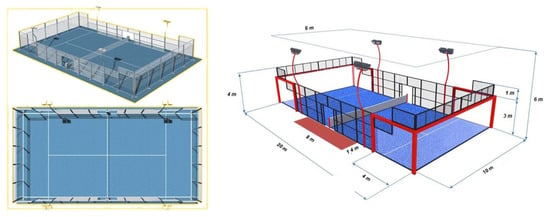
Figure 1
Open AccessArticle
Effects of Resistance Training Experience on Bone Mineral Density and Stress Fractures in Female College Athletes: A Retrospective Cohort Study
by
Tetsuro Kobayashi, Shotaro Seki, Mengrong Liu, Itaru Chiba, Takashi Oguro, Yosuke Makino, Yasunaga Kobayashi, Hiroyuki Matsumoto and Inkwan Hwang
Sports 2025, 13(7), 227; https://doi.org/10.3390/sports13070227 - 10 Jul 2025
Abstract
►▼
Show Figures
This study aimed to investigate the effects of resistance training (RT) experience on bone mineral density (BMD) and stress fractures (SFs) in female collegiate athletes. Overall, 492 female athletes from 16 competitive sports were included. Sports were categorized into four groups based on
[...] Read more.
This study aimed to investigate the effects of resistance training (RT) experience on bone mineral density (BMD) and stress fractures (SFs) in female collegiate athletes. Overall, 492 female athletes from 16 competitive sports were included. Sports were categorized into four groups based on exercise load. Data on sports participation, RT experience, and SF history were obtained using a questionnaire. Total body and lumbar spine BMD were measured using dual-energy X-ray absorptiometry. Athletes with RT experience in both senior high school (ages 15–18) and university (ages 18–22), as well as those with experience from junior high school (ages 12–15) through university, had significantly higher BMD than those with no RT experience or RT experience only in senior high school (p < 0.05). Logistic regression analysis revealed that athletes with RT experience had significantly lower odds ratios for SFs compared to those with no RT experience. In the adjusted model that included sport type and university year, athletes with RT experience in junior high school, senior high school, and university had a significantly lower OR for SFs compared with no RT experience (OR = 0.06, 95% CI: 0.01–0.59, p = 0.016). No significant BMD differences were found between athletes with and without SFs (p > 0.05). The study findings suggest that initiating RT in junior high school may be associated with a reduced incidence of SFs during university.
Full article
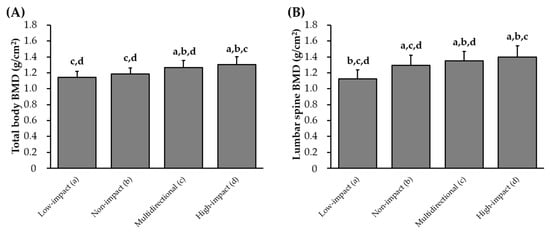
Figure 1
Open AccessArticle
Relationship Between Early and Maximal Isometric Upper-Body Push and Pull Force Production Among Elite Female and Male Swedish Track and Field Throwers
by
Jesper Augustsson, Ted Gunhamn and Håkan Andersson
Sports 2025, 13(7), 226; https://doi.org/10.3390/sports13070226 - 10 Jul 2025
Abstract
►▼
Show Figures
Maximal and explosive strength—defined as the ability to rapidly generate high levels of force—are widely recognized as critical for performance in strength–power sports such as track and field throwing. However, their interrelationship remains insufficiently examined, particularly in the upper body of elite athletes.
[...] Read more.
Maximal and explosive strength—defined as the ability to rapidly generate high levels of force—are widely recognized as critical for performance in strength–power sports such as track and field throwing. However, their interrelationship remains insufficiently examined, particularly in the upper body of elite athletes. This study examined the relationship between early force production (≤250 ms, subdivided into early phase: 0–100 ms; late phase: 100–250 ms) and peak isometric upper-body push and pull force in elite Swedish track and field throwers. A total of 30 athletes (17 females, 13 males; aged 18–34 years), all competing nationally or internationally in discus, hammer, shot put, or javelin, participated in a cross-sectional assessment. Isometric force was measured during bench press (push) and supine bench row (pull) using a custom-built device. Force output was recorded at 50, 100, 150, 200, and 250 ms, along with peak force. The results showed a progressive increase in the correlation between force at early time points and peak force. Associations were weak to moderate at 50–100 ms (r = 0.07–0.55) and became strong to very strong at 150–250 ms (r = 0.64–0.92). These patterns were consistent across sexes and test types. The findings suggest that maximal strength becomes increasingly important as force production time extends beyond 100 ms. Coaches may benefit from assessing both early and peak force characteristics to inform strength profiling and guide training focus, though further research is needed to determine their impact on performance.
Full article
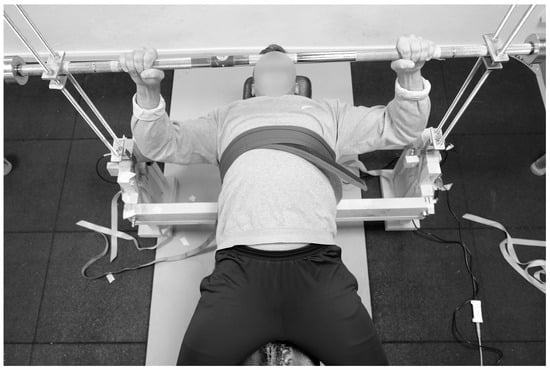
Figure 1
Open AccessReview
Elite Ice Hockey Players’ Well-Being: A Scoping Review
by
Pierre-Luc Veillette, Stéphanie Girard, Jason D’Amours, Vincent Huard Pelletier and Paule Miquelon
Sports 2025, 13(7), 225; https://doi.org/10.3390/sports13070225 - 9 Jul 2025
Abstract
►▼
Show Figures
As mental health has gained prominence in recent years, elite ice hockey players have shared their experience of psychological problems, including adverse alcohol use, anxiety, depression, distress, eating disorders, and sleep disturbances. Mental health remains a sensitive issue for ice hockey players, as
[...] Read more.
As mental health has gained prominence in recent years, elite ice hockey players have shared their experience of psychological problems, including adverse alcohol use, anxiety, depression, distress, eating disorders, and sleep disturbances. Mental health remains a sensitive issue for ice hockey players, as stigma, a strong hockey culture, lack of mental health literacy, and negative past experiences with seeking help constitute barriers to seeking support. This scoping review aims to identify the psychological factors contributing to elite ice hockey players’ well-being. After screening the titles and abstracts of three databases within a 2002–2025 timeframe, a total of 517 articles were retrieved. Seventeen articles targeting ice hockey athletes over 14 years of age competing at an elite level were selected. Three main categories emerged from the included studies: anxiety and depressive symptoms, motivational variables, and coping strategies at different career stages. Factors such as retirement, concussions, social support, parenting style, task-approach goals, and task-oriented behavior were influential components to the well-being and mental health of elite ice hockey players. Using the Lazarus and Folkman model, the identified psychological factors may help athletes and various actors surrounding them to better understand athletes’ well-being.
Full article
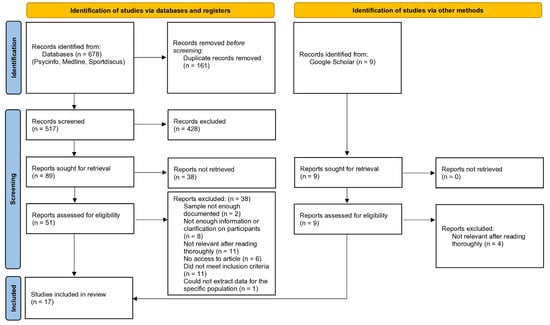
Figure 1
Open AccessArticle
How Does Load Selection and Sex Influence 1RM Prediction Using the Minimal Velocity Threshold During Free-Weight Back Squat?
by
Emanuele Dello Stritto, Ruggero Romagnoli, Michele Nocchi and Maria Francesca Piacentini
Sports 2025, 13(7), 224; https://doi.org/10.3390/sports13070224 - 8 Jul 2025
Abstract
The aim of the present study is to predict a 1RM through the load–velocity relationship using the minimum velocity threshold (MVT) in a free-weight back squat. Twenty-five males and twenty-five females performed a 1RM test during a free-weight back squat, based on which
[...] Read more.
The aim of the present study is to predict a 1RM through the load–velocity relationship using the minimum velocity threshold (MVT) in a free-weight back squat. Twenty-five males and twenty-five females performed a 1RM test during a free-weight back squat, based on which individual load–velocity relationships were created. Ten regression models to predict the 1RM were developed. The models included a two-point (mean propulsive velocity (MPV) ≈ 1 m·s−1; MPV ≈ 0.50 m·s−1) and a three-point linear equation (MPV ≈ 1 m·s−1; MPV ≈ 0.75 m·s−1; and MPV ≈ 0.50 m·s−1) with an MVT of 0.3 m·s−1 and 0.4 m·s−1 and, additionally, an MVT of 0.25 m·s−1 for females. The repeated measures ANOVA revealed no significant differences between the predicted and measured 1RM in males using an MVT of 0.30 m·s−1 and in females with an MVT of 0.25 m·s−1. In contrast, models using an MVT of 0.30 m·s−1 in females underestimated the measured 1RM, as did those using an MVT of 0.40 m·s−1 in both sexes. It appears possible to accurately predict the 1RM during a free-weight back squat using the load–velocity relationship. However, it is important to avoid using loads with velocities higher than 1 m·s−1 for the regression models and to use different MVTs for males and females.
Full article
(This article belongs to the Special Issue Human Physiology in Exercise, Health and Sports Performance)
►▼
Show Figures
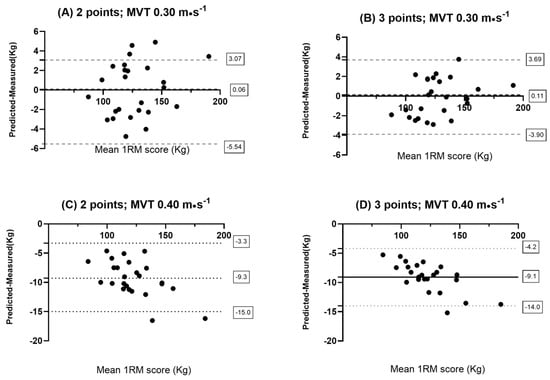
Figure 1
Open AccessArticle
Choreographing Well-Being: The Predictive Role of Self-Compassion on Life Satisfaction—A Therapeutic-Based Art Pedagogy Perspective in Recreational Dance
by
Aglaia Zafeiroudi, Thomas Karagiorgos, Ioannis Tsartsapakis, Gerasimos V. Grivas, Charilaos Kouthouris and Dimitrios Goulimaris
Sports 2025, 13(7), 223; https://doi.org/10.3390/sports13070223 - 8 Jul 2025
Abstract
Dance encompasses physical, emotional, and social elements, creating a dynamic platform for the exploration of well-being. As a therapeutic approach, dance movement further applies these dimensions to enhance emotional resilience, foster mindfulness, and improve overall mental health. This study examined the relationship between
[...] Read more.
Dance encompasses physical, emotional, and social elements, creating a dynamic platform for the exploration of well-being. As a therapeutic approach, dance movement further applies these dimensions to enhance emotional resilience, foster mindfulness, and improve overall mental health. This study examined the relationship between self-compassion and life satisfaction among 912 recreational dancers (80% female and 20% male) in Greece. Participants completed the Self-Compassion Scale and Satisfaction with Life Scale. Confirmatory Factor Analysis validated the five-factor self-compassion model, and regression analysis identified predictors of life satisfaction. Self-kindness emerged as a strong positive predictor (β = 0.258, p < 0.001), while isolation (β = −0.307, p < 0.001) and self-judgment (β = −0.083, p = 0.029) negatively predicted life satisfaction. Common humanity (β = 0.064, p = 0.066) and mindfulness (β = 0.004, p = 0.907) showed no significant predictive effect. The model explained 21.7% of the variance in life satisfaction (R2 = 0.217). Small but statistically significant differences in self-compassion dimensions were observed across dance styles. Partner-oriented dancers such as those practicing tango reported slightly higher self-kindness and mindfulness, while ballet dancers showed a small increase in self-judgment and isolation. Life satisfaction remained consistent across styles, highlighting dance’s overall contribution to well-being. These findings suggest that integrating self-compassion training into dance education and psychotherapy, particularly within a Therapeutic-Based Art Pedagogy framework, may contribute to emotional resilience, foster social connection, and promote mental health, positioning dance as a potentially transformative tool for holistic development.
Full article
Open AccessFeature PaperArticle
The Relationship Between Strap Use and Classification Score in Elite Wheelchair Basketball Players
by
Giacomo Farì, Francesco Quarta, Sara Clelia Longo, Fernando Zappile, Laura Masiero, Giustino Varrassi and Andrea Bernetti
Sports 2025, 13(7), 222; https://doi.org/10.3390/sports13070222 - 8 Jul 2025
Abstract
Wheelchair basketball (WB) grants important benefits for people with disabilities but also presents a relevant risk of injury. Wheelchair straps are restraint devices that can improve safety and performance, but limited research has explored their use in WB. This study aims to analyze
[...] Read more.
Wheelchair basketball (WB) grants important benefits for people with disabilities but also presents a relevant risk of injury. Wheelchair straps are restraint devices that can improve safety and performance, but limited research has explored their use in WB. This study aims to analyze the use of different types of straps among professional WB players, according to classification score. A cross-sectional study was conducted through an online survey. Participants were divided into two groups based on classification score: low-point players (LPPs; 1.0–2.5), who have greater physical impairment, and high-point players (HPPs; 3.0–4.5), who have lower physical impairment. A total of 82 WB players participated (43 LPPs; 39 HPPs). The Chi-squared test was used to compare variables between groups. Significant differences emerged: chest (p = 0.036), abdominal (p = 0.036), and foot (p = 0.016) straps were more frequently used by LPPs, while thigh (p = 0.020) and leg (p = 0.050) straps were more common among HPPs. No significant difference was found for pelvic strap. Straps used in WB vary with classification score, reflecting the influence of functional ability. These findings offer insights into individualized wheelchair setup and classification procedures. Further studies are needed to expand knowledge on this topic.
Full article
(This article belongs to the Special Issue Researching Physical Activity and Participation in Adapted Sports for People with Disabilities)
Open AccessArticle
Single-Bout Strength: Acute Mental Health Responses to Resistance Training in Active Adults
by
Manuel Amore, Adolfo Alfarano, Vincenzo Sorgente, Giulia Panconi, Sara Guarducci, Riccardo Bravi and Diego Minciacchi
Sports 2025, 13(7), 221; https://doi.org/10.3390/sports13070221 - 7 Jul 2025
Abstract
►▼
Show Figures
Background: Emerging evidence highlights the role of physical exercise as a non-pharmacological intervention for reducing symptoms of anxiety and depression. While most research has focused on aerobic modalities and chronic training programs, the acute psychological impact of resistance training (RT)—particularly in healthy, active
[...] Read more.
Background: Emerging evidence highlights the role of physical exercise as a non-pharmacological intervention for reducing symptoms of anxiety and depression. While most research has focused on aerobic modalities and chronic training programs, the acute psychological impact of resistance training (RT)—particularly in healthy, active individuals—remains underexplored. This study addresses this gap by evaluating the immediate effects of a single RT session on anxiety and depression in healthy, active individuals. Methods: Fifty-six healthy, physically active participants (43 males, 13 females; M age = 24.41 ± 4.41 years) were randomly assigned to an experimental group (RT, n = 30) or a control group (stretching/mobility, n = 26). The RT session included multi-joint exercises performed at 70–75% 1RM, while the control session consisted of non-load-based mobility and flexibility exercises. Psychological responses were measured immediately before and five minutes after the session using the Hospital Anxiety and Depression Scale (HADS), which includes subscales for anxiety (HADS-A) and depression (HADS-D). Results: Non-parametric within-group analysis (Wilcoxon Signed-Rank Test) revealed a significant reduction in anxiety scores in the RT group (Z = −3.3, p < 0.001, r = −0.7), and a moderate but significant decrease in depression (Z = −2.8, p = 0.005, r = −0.6). No significant changes were observed in the control group for either variable. Between-group comparisons (Mann–Whitney U) showed significantly greater reductions in anxiety in the RT group (p = 0.021), while differences in depression deltas were not significant. A Quade ANCOVA confirmed that group assignment is significantly predictive for post-intervention anxiety levels (F(1, 54) = 8.46, p = 0.005), controlling for baseline values. Conclusions: A single session of moderate-to-high-intensity resistance training can acutely reduce anxiety symptoms in healthy physically active individuals. The effect on depressive symptoms appears more modest and variable, suggesting differential sensitivity to acute exercise stimuli. These findings support the use of RT not only for long-term psychological health but also as a feasible short-term intervention for emotional regulation in healthy active populations.
Full article

Figure 1
Open AccessArticle
Iron Deficiency Prevention and Dietary Habits Among Elite Female University Athletes in Japan
by
Hiromi Inaba, Haruo Hanawa, Fumi Hoshino, Mutsuaki Edama and Go Omori
Sports 2025, 13(7), 220; https://doi.org/10.3390/sports13070220 - 7 Jul 2025
Abstract
This study investigated the percentage of iron deficiency anemia (IDA) and iron deficiency (ID) among 71 elite female athletes at a Japanese university and assessed their dietary habits. IDA was identified in 9.9% (n = 7) of participants, and only 22.5% (
[...] Read more.
This study investigated the percentage of iron deficiency anemia (IDA) and iron deficiency (ID) among 71 elite female athletes at a Japanese university and assessed their dietary habits. IDA was identified in 9.9% (n = 7) of participants, and only 22.5% (n = 16) self-reported dietary practices aimed at preventing or managing ID/IDA. Notably, 52.1% (n = 37) of the athletes exhibited IDA or ID but lacked an appropriate dietary approach. Moreover, even among those who reported an intentional dietary approach to the prevention or management of ID/IDA, the intake of iron- and vitamin C-rich foods was insufficient, limiting the effectiveness of their efforts. These findings highlight a gap between awareness and effective practice, indicating that many female athletes in Japan, despite being at elevated risk, do not follow evidence-based dietary strategies for preventing or treating ID/IDA. Targeted nutritional education and routine screening of iron status are strongly recommended for this population.
Full article
(This article belongs to the Special Issue Enhancing Performance and Promoting Health Through Nutrition)
Open AccessReview
Police Fitness: An International Perspective on Current and Future Challenges
by
Robin Orr, Elisa F. D. Canetti, Suzanne Gough, Kirstin Macdonald, Joe Dulla, Robert G. Lockie, J. Jay Dawes, Sam D. Blacker, Gemma S. Milligan and Ben Schram
Sports 2025, 13(7), 219; https://doi.org/10.3390/sports13070219 - 7 Jul 2025
Abstract
►▼
Show Figures
Poor officer fitness can lead to decreased occupational task performance, injuries, increased absenteeism, and a variety of negative health sequalae further adding to the challenges of staffing law enforcement agencies. Optimizing the physical fitness for both serving officers and new recruits is critical
[...] Read more.
Poor officer fitness can lead to decreased occupational task performance, injuries, increased absenteeism, and a variety of negative health sequalae further adding to the challenges of staffing law enforcement agencies. Optimizing the physical fitness for both serving officers and new recruits is critical as their loss is, and will increasingly be, difficult to replace. However, maintaining and recruiting a physically fit workforce faces several challenges. For serving officers, shiftwork is known to decrease motivation to exercise and negatively impact sleep and diet. Additional factors impacting their fitness includes age-related declines in fitness, increasing obesity, long periods of sedentarism, and negative COVID-19 effects. Concurrently, recruiting physically fit recruits is challenged by declining levels of fitness, reduced physical activity, and increasing obesity in community youth. Ability-based training (ABT), individualizing physical conditioning training based on the existing fitness levels of individuals within a group, offers a potential solution for delivering physical conditioning to groups of applicants, recruits, and officers with a range of physical fitness capabilities. Law enforcement agencies should consider implementing ABT during academy training and ongoing fitness maintenance to minimize injury risk and optimize task performance.
Full article

Figure 1
Open AccessArticle
A Novel, Sport-Specific EMG-Based Method to Evaluate Movement Efficiency in Karate Punching
by
László Csákvári, Bence Kopper and Tamás Horváth
Sports 2025, 13(7), 218; https://doi.org/10.3390/sports13070218 - 7 Jul 2025
Abstract
►▼
Show Figures
Background: This study aimed to develop a method to analyze the kinetic and kinematic characteristics of the traditional karate Gyaku Tsuki (reverse punch), focusing on the activation sequence of lower and upper extremities and trunk muscles during execution. Methods: An elite male (N
[...] Read more.
Background: This study aimed to develop a method to analyze the kinetic and kinematic characteristics of the traditional karate Gyaku Tsuki (reverse punch), focusing on the activation sequence of lower and upper extremities and trunk muscles during execution. Methods: An elite male (N = 1) karate athlete (in kata) performed 20 Gyaku Tsuki punches while equipped with 16 wireless surface EMG sensors integrated with 3-axis accelerometers. The five punches with the highest forearm acceleration were selected for analysis. EMG, accelerometer, and synchronized video data were recorded and processed. Results: A novel visualization technique was developed to represent muscle activation over time, distinguishing a spectrum of 0–25–50–75–100% activation levels. Muscle activation times for arm, leg, and trunk muscles ranged from −0.31 to −0.11 s relative to punch execution, indicating rapid, coordinated muscle engagement. Conclusions: This method enables detailed analysis of muscle activation patterns in karate punches. It offers valuable insights for biomechanics researchers and practical applications for coaches aiming to enhance performance and prevent injuries through better understanding of movement dynamics.
Full article
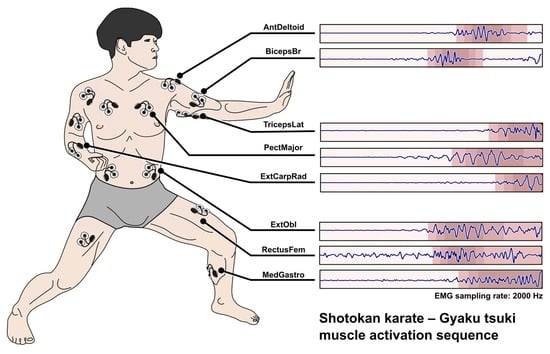
Graphical abstract
Open AccessArticle
Effects of a Daily Mile Program During Recess on Physical Fitness in Adolescents: A Comparative Pilot Study of Weekly Frequency and Gender Differences Among Students in a Region of Spain
by
Rubén Navarro-Patón, Miguel Cons-Ferreiro, María Muíño-Piñeiro and Marcos Mecías-Calvo
Sports 2025, 13(7), 217; https://doi.org/10.3390/sports13070217 - 7 Jul 2025
Abstract
Background: Recess provides a valuable opportunity for physical activity for students at school. However, there is no clear evidence regarding the effects of running a mile daily on schoolchildren’s physical fitness. The objective of this study was to identify and evaluate the effects
[...] Read more.
Background: Recess provides a valuable opportunity for physical activity for students at school. However, there is no clear evidence regarding the effects of running a mile daily on schoolchildren’s physical fitness. The objective of this study was to identify and evaluate the effects of running a mile daily during recess in a school setting over a 12-week period. Methods: The study included 68 students (39 boys and 29 girls) aged 13 to 16 years (14.45 ± 1.08) from secondary education (Spain). Participants were randomly assigned to one of three groups. Intervention Group 1 (IG1): one-mile run once per week (22 students). Intervention Group 2 (IG2): one-mile runs three times per week (21 students). Intervention Group 3 (IG3): one-mile runs five times per week (25 students). Physical fitness was assessed using the following tests: Broad jump (lower limb strength); Sit and Reach (lower limb flexibility); 4 × 10 m shuttle runs (speed, agility, and coordination); 10 × 5 m shuttle runs (displacement speed); 20 m shuttle run (Course Navette) (cardiorespiratory endurance). Results: Broad jump: No overall post-intervention differences were observed (p > 0.05), but there were pre-existing gender differences [boys outperform girls in IG2 and IG3 (p < 0.05)] that widened after the program, even appearing in IG1 (p = 0.031). Sit and Reach: No overall changes occurred (p > 0.05), but gender differences emerged in IG3 after the intervention [girls outperformed boys (p < 0.050)], and IG3 boys showed a decrease in flexibility after the program (p = 0.041). The 4 × 10 m shuttle runs: Initial differences between IG1 vs. IG3 disappeared after the intervention, with an overall increase in test time (p > 0.005). Pre-existing gender differences decreased, except in IG2 (boys remained faster; p < 0.001). The 10 × 5 m shuttle runs: Significant improvements were observed in all post-intervention groups (p = 0.003), with the greatest gains in IG3 boys (p < 0.001) and IG1 girls (p = 0.003). The 20 m shuttle run: Significant improvements occurred in IG1 and IG3 (p < 0.005), particularly in IG3 boys (p = 0.002) and IG1 girls (p = 0.019). Conclusions: Although effects varied by fitness component, intervention frequency, and gender, daily mile running was shown to be a viable strategy for improving aspects of fitness in adolescents, particularly endurance and speed, even at lower frequencies.
Full article
(This article belongs to the Special Issue Advances in Motor Behavior and Child Health)
►▼
Show Figures
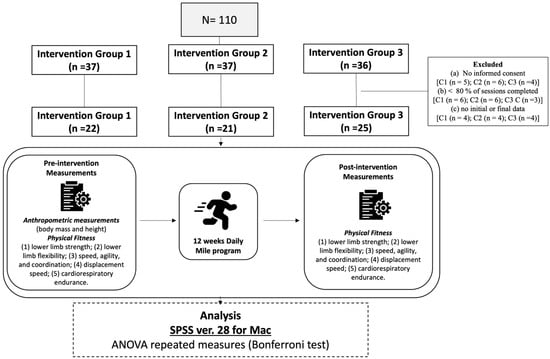
Figure 1
Open AccessArticle
Reliability of Capillary Blood Gas Measurements in Paralympic Sprinters at Rest: A Pilot Study
by
Thiago Fernando Lourenço, Samuel Bento da Silva, Vinícius Miguel Zanetti, Ana Gabriela Almeida Maximo Pereira, João Vitor Ichikawa Quintella, Oriane Martins, Amaury Verissimo and Lazaro Alessandro Soares Nunes
Sports 2025, 13(7), 216; https://doi.org/10.3390/sports13070216 - 4 Jul 2025
Abstract
Background: Sports scientists have increasingly used point-of-care methods for training load management, and blood gas analysis has shown promise in this area. However, the reproducibility of this method in high-performance athletes remains unproven. Objective: The aim of this study was to verify the
[...] Read more.
Background: Sports scientists have increasingly used point-of-care methods for training load management, and blood gas analysis has shown promise in this area. However, the reproducibility of this method in high-performance athletes remains unproven. Objective: The aim of this study was to verify the reliability of acid-base variables at rest in high-performance Paralympic sprinters. Methods: Seven athletes participated, including four with visual impairments (class T12 and T13) and three with physical impairments. Approximately 500 µL of capillary blood was obtained from the fingertip and analyzed in triplicate (Samples 1, 2, and 3) using the Epoc System® (Ottawa, ON, Canada) to measure pH, carbonic dioxide partial pressure (pCO2), bicarbonate ion (HCO3−), base excess (BE), hematocrit (Hct), hemoglobin concentration (Hb), creatinine (CRE), and urea concentration (URE). Results: No differences were found for any parameter (p > 0.05). The imprecision of the method ranged from 0.1% for blood pH to 6.1% for BE. Pearson’s analysis showed strong and significant relationships between all variables analyzed (p < 0.05). The degree of consistency among samples also indicated excellent reliability of measurements, ranging from 0.88 for Hb to 1.00 for URE. Conclusions: These results indicate that acid-base status measurements using point-of-care demonstrated excellent reliability in high-level athletes, supporting sports scientists and coaches for athlete training and management.
Full article
Open AccessReview
Exercise-Induced Angioedema, Urticaria, and Anaphylaxis—A Narrative Review
by
Waleed Aman Ur Rahman, Mohamad Mahdi Mortada, Paulina Ślimok, Alaa Sherri, Katarzyna Poznańska-Kurowska, Anna Zalewska-Janowska and Marcin Kurowski
Sports 2025, 13(7), 215; https://doi.org/10.3390/sports13070215 - 3 Jul 2025
Abstract
►▼
Show Figures
The benefits of regular physical exercise, primarily moderate-intensity exercise, are widely known, recognized, and acclaimed. As an important lifestyle modification, regular training activities are gaining increasing popularity in the general population. Apart from the obvious benefits, physical exercise may carry the risk of
[...] Read more.
The benefits of regular physical exercise, primarily moderate-intensity exercise, are widely known, recognized, and acclaimed. As an important lifestyle modification, regular training activities are gaining increasing popularity in the general population. Apart from the obvious benefits, physical exercise may carry the risk of trauma, cardiovascular events, and exercise-induced asthma and bronchoconstriction, to name just a few well-known clinical situations reported in athletes, both recreational and competitive. In susceptible individuals, acute bouts of exercise may lead to the appearance of urticaria, angioedema, and anaphylaxis. Among these three clinical phenomena, angioedema is the least addressed and recognized, often being considered an accompanying clinical feature of urticaria or a hallmark of imminent anaphylactic reaction. To fill this knowledge gap, in this review, we focus on exercise-associated angioedema symptoms and highlight their most important features, both as isolated phenomena and in association with urticaria or anaphylaxis.
Full article
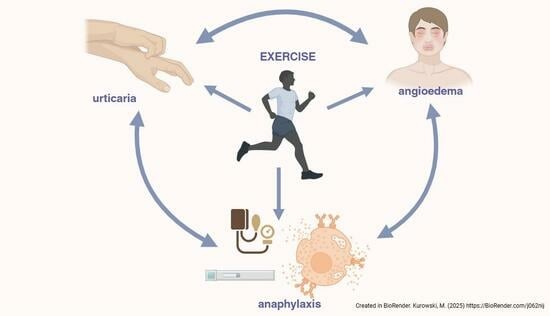
Graphical abstract

Journal Menu
► ▼ Journal Menu-
- Sports Home
- Aims & Scope
- Editorial Board
- Topical Advisory Panel
- Instructions for Authors
- Special Issues
- Topics
- Article Processing Charge
- Indexing & Archiving
- Editor’s Choice Articles
- Most Cited & Viewed
- Journal Statistics
- Journal History
- Journal Awards
- Society Collaborations
- Conferences
- Editorial Office
Journal Browser
► ▼ Journal BrowserHighly Accessed Articles
Latest Books
E-Mail Alert
News
Topics
Topic in
Applied Sciences, JFMK, Sports, Children
Movement and Health: Holistic Development to Support Long-Term Active Lifestyles
Topic Editors: Francesco Sgrò, David StoddenDeadline: 31 December 2025
Topic in
Biomechanics, JFMK, Sports
Concurrent Strength and Endurance Training
Topic Editors: Alejandro Pérez-Castilla, Manuel A. Rodríguez PérezDeadline: 28 February 2026
Topic in
Biomechanics, JFMK, Sensors, Sports
Current Perspectives and Future Directions in Sports Biomechanics
Topic Editors: Pedro Forte, Rafael Peixoto, Luís BranquinhoDeadline: 25 May 2026
Topic in
Education Sciences, Sports
Sustainability-Oriented Learning in Physical Education and Health (PEH)
Topic Editors: Suzanne Lundvall, Andreas FröbergDeadline: 15 June 2026

Conferences
Special Issues
Special Issue in
Sports
Neuromechanical Adaptations to Exercise and Sports Training
Guest Editor: Denis César Leite VieiraDeadline: 20 July 2025
Special Issue in
Sports
Physical Activity for Preventing and Managing Falls in Older Adults
Guest Editor: António MonteiroDeadline: 20 July 2025
Special Issue in
Sports
Cutting-Edge Research on Physical Fitness Profile in Soccer Players
Guest Editor: Ioannis MichailidisDeadline: 25 July 2025
Special Issue in
Sports
The Prevention and Rehabilitation of Training Injuries
Guest Editor: Blanca de la Cruz-TorresDeadline: 31 July 2025







